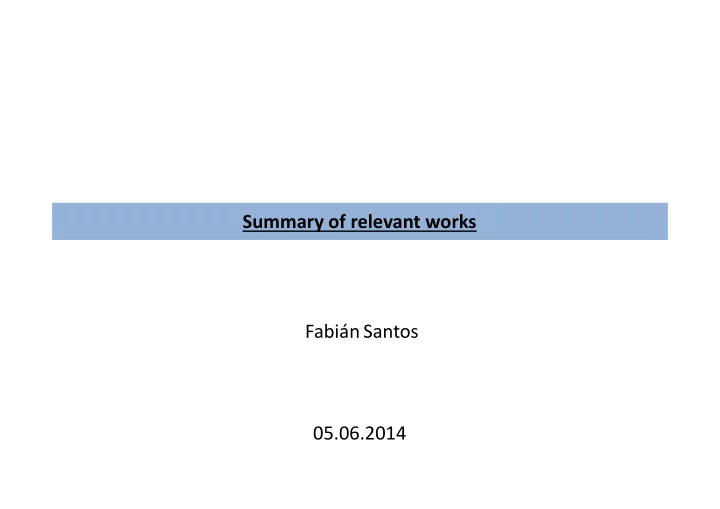

Summary of relevant works Fabián Santos 05.06.2014
Deforestation on tropical forests from image processing of Landsat 7 with scan-off and clouds cover in the sector Auca Sur, Yasuni National Park – Ecuador (master degree dissertation)
Study area: Background: Objective: • Ecuador had for some • Predict deforestation in tropical years, the highest forests with high cloud cover deforestation rate in and scan-off Landsat images Southamerica (FAO, 2010) Processing chain: • Lack of deforestation methodologies which treat Spectral mixture decomposition bad quality Landsat images with ImageTools (IMAZON, 2013): *Green vegetation Post-processing: Pre-processing chain: *Non-photosynthetic vegetation *Soils Soil – GV – NPV *Shades R – G – B Scan-off & Data cloud gap fill with ERDAS Visual inspection Modeler (Leica Modeler (Leica and edition of and edition of Geosystems, 2007) errors Normalized Difference Fraction Index or NDFI (Souza, 2006) Radiance Conversion with ImageTools (IMAZON, 2013) Atmospheric High resolution NDFI classification Correction with images & field data with ImageTools FLAASH (ITT, 2013) on a stratified (IMAZON, 2013) sampling for a confusion matrix Haze filter Enhancement with ImageTools (IMAZON, 2013)
Results: Modelling deforestation scenarios: • Three model scripts for recover scan-off and 1 2 34 14 13 cloud data gaps Predictors + deforestation 12 • Kappa values for the deforestation maps (2000 – control maps 11 (Dinamica Ego, 2009) 5 10 2008) were over 0.76 and the calibration of the 6 9 7 8 deforestation scenario achieve 0.67 • Square matrix style calculations, helps to reveals hotspots of deforestation Finding out the drivers of deforestation & validation Other relevant issues: of models (Dinamica Ego, 2009) • Imgtools (IMAZON, 2013) methodology was applied for the whole Amazon Region of Ecuador and publicy on the Atlas of “Amazonia bajo Presion” (RAISG, 2012) bajo Presion” (RAISG, 2012) Appliance of “Simulate Deforestation with Patch formation and Expansion“ model (Dinamica Ego, 2009) Calculation of deforestation rates: Time period Tax calculation Site identification Square matrix (25 km 2 ) for obtain deforestation taxes (FAO & Puyravaud formulas) More information at: http://raisg.socioambiental.org/
A framework for Mapping Potential Strata Forests on Ecuador (technical report)
Objective: Study area: Background: • Update the Potential Strata • For REDD+ purposes, a Forest Map with a replicable Potential Strata Forests Map methodology was request for quantify greenhouse gases emissions Data extraction: • Previous version of a Hexagon database potential map (MAE, 2013) system for data collection (25 ha Ecuador regions Remaining strata forests had a not clear and each analysis unit) Decision tree formulas: replicable methodology Flowchart: Possible unique variable combinations and regresion formulas Predictor variables collection collection (total 11) Extraction of data Prediction & Validation: Output 1 + Output 2 + Output N Samples Outliers detection and elimination 1. Data extraction Samples 2. Decision tree creation collection 3. Prediction & validation 4. Map plotting 5. Discussion & edition
Map plotting: Other relevant issues: • The methodology could be applied in other distribution exercises, as for example species or Workshop for identify the quality of the results crops potential distributions, also climate change scenarios and its implications over biodiversity, food security, etc. Final result • The output map was used on the REDD+ after editing the errors reference scenario of greenhouse emission identified calculation, achieving the transparence of the methodology applied and its replication as better data is available Results: • A methodology based on a set of 7 scripts programmed on R (Ihaka, R. and R. Gentleman ,2013) were developed • Decision tree algorithm (Therneau, T., B. Atkinson, et al. ,2013) achieved regression outputs of 0.86, 0.79, and 0.90 kappa values for the best models
Acknowledgments References •Dinamica Ego (2009). Dinamica EGO. 1.6 ed. Minas Gerais - Brazil, Centro de Sensoriamento Remoto, Universidade Federal de Minas Gerais. •FAO (2010)."Global Forest Resources Assessment 2010.Progress towards sustainable forest management. Global tables.".Retrieved 10/07/2013, 2013, from http://www.fao.org/forestry/fra/fra2010/en/. •Ihaka, R. and R. Gentleman (2013). "The R Project for Statistical Computing." 3.0.1. from http://www.r-project.org/. •IMAZON (2010). Imgtools - Monitoramento da Amazônia •ITT Visual Information Solutions (2009). ENVI 4.6 ed. •Leica Goesystems (2007). ERDAS IMAGINE 9.2 ed. •MAE (2013). Representación Cartográfica de los Estratos de Bosque del Ecuador Continental. Subsecretaría de Patrimonio Natural. Quito - Ecuador, Ministerio del Ambiente del Ecuador (MAE). •RAISG (2012). Amazonía Bajo Presión. A. Rolla, B. Ricardo, D. Larrea, J. Ulloa and N. Hernández. Sao Paulo - Brasil. •Souza, C., D. Roberts, et al. (2005). Combining spectral and spatial information to map canopy damage from selective logging and forest fires. Remote Sensing of Enviroment 98 (2005) - ELSEVIER, 15. •Therneau, T., B. Atkinson, et al. (2013). "rpart: Recursive Partitioning." from http://cran.r- project.org/web/packages/rpart/index.html.
Recommend
More recommend